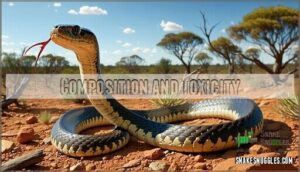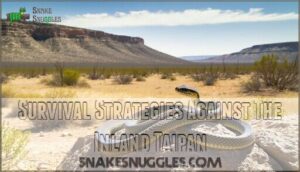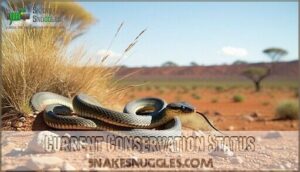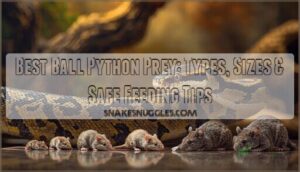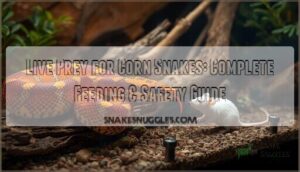This site is supported by our readers. We may earn a commission, at no cost to you, if you purchase through links.

That’s roughly the weight of a single grain of salt! This Australian serpent packs enough venom in one bite to drop 100 adult humans, earning its title as the world’s most venomous snake.
While that sounds terrifying, here’s the kicker: inland taipans are actually shy creatures that prefer avoiding humans altogether.
They’d rather spend their days hunting rats in Australia’s remote outback than dealing with nosy tourists.
The venom works fast, attacking your nervous system and blood clotting.
But there’s more to this deadly beauty than just its fearsome reputation.
Table Of Contents
- Key Takeaways
- Understanding The Inland Taipan
- The Venom of The Inland Taipan
- Survival Strategies Against The Inland Taipan
- Conservation Status and Threats
- The Inland Taipan in Culture and Media
- Population Number
- What is The Most Venomous Snake in The World?
- Just Curious for More? We’ve Got You Covered
- Frequently Asked Questions (FAQs)
- How much inland taipan venom can kill a person?
- Are inland taipan snakes poisonous?
- Does the inland taipan kill humans?
- What is the LD50 of inland taipan venom?
- Is taipan poisonous?
- How are inland taipan bite victims treated?
- How does Inland Taipan venom affect the body?
- What are the chances of survival if bitten?
- How does the Inland Taipans venom compare to others?
- What are the chances of encountering one?
- Conclusion
Key Takeaways
- You’d need just 0.025 milligrams per kilogram of body weight to reach the lethal dose – that’s roughly the weight of a grain of salt for most adults
- You’re extremely unlikely to encounter one since inland taipans live in remote Australian deserts and actively avoid humans, making them one of the world’s most reclusive venomous snakes
- You’ll survive an inland taipan bite if you get immediate medical treatment with antivenom – there’s never been a recorded human death from this snake despite its deadly reputation
- You’re dealing with venom that’s 50 times more toxic than a cobra’s, capable of killing 100 adults from a single bite, yet these shy creatures prefer hunting rats over confronting humans
Understanding The Inland Taipan
You’ll encounter Australia’s most venomous snake in the remote deserts of central-eastern Australia, where this slender, light brown serpent changes color with the seasons.
The inland taipan measures around 6 feet long and prefers avoiding humans entirely, making it one of nature’s most reclusive yet deadly creatures.
Defining Characteristics
The inland taipan, known as the most venomous snake worldwide, features distinctive Physical Attributes including slender builds measuring 1.8-2.5 meters with light brown coloration and darker patches.
Despite their deadly reputation for snake venom toxicity with an extremely low taipan lethal dose, these serpents display surprisingly docile Temperament.
Their precise Bite Mechanics and Evolutionary Adaptations make them efficient hunters, though their Venom Yield varies seasonally with their remarkable color-changing ability.
Natural Habitat and Distribution
When you’ve learned about their defining characteristics, you’ll naturally wonder where these venomous serpents actually live.
The inland taipan habitat spans Australia’s most challenging environments, where these snakes have developed remarkable arid adaptations.
Despite habitat loss threatening their survival, these creatures continue to thrive in specific Australian ecosystems.
Taipan distribution remains concentrated in remote areas where prey abundance supports their populations, though regional variations exist across their range.
Their survival depends on effective camouflage techniques to both hunt and avoid predators.
You’ll find these deadly snakes in four primary Australian deserts locations:
- Channel Country (Queensland) – Semi-arid plains with abundant rodent populations
- Marree-Innamincka District (South Australia) – Remote gibber plains and floodplains
- Coober Pedy area – An isolated population in South Australia’s mining region
- Black soil plains – Cracking clay environments perfect for snake habitats
These snake habitats offer the perfect combination of shelter and hunting grounds.
The Venom of The Inland Taipan
When you’re dealing with the world’s most venomous land snake, understanding exactly what makes its bite so deadly becomes essential for your safety.
The inland taipan’s venom packs enough punch to kill 100 adults with a single bite, making it roughly 50 times more toxic than a cobra’s venom.
Composition and Toxicity
Now that you understand what makes the Inland Taipan so distinctive, let’s examine what makes its inland taipan venom so incredibly dangerous.
With an LD50 of just 0.025 mg/kg, this venom toxicity levels represent the most potent snake venom composition on Earth.
The venom complexity includes multiple neurotoxin types like paradoxin and oxylepitoxin-1 that shut down your nervous system by blocking nerve signals.
Procoagulant activity disrupts your blood’s ability to clot properly, while myotoxin effects break down muscle tissue throughout your body.
A spreading factor called hyaluronidase acts like a highway system, rapidly transporting these toxins through your bloodstream.
This venom potency means just one milligram could prove fatal to an adult human.
The Inland Taipan’s habitat is typically found in semi arid regions of central eastern Australia, making human encounters relatively rare.
Effects on The Human Body
When inland taipan venom enters your bloodstream, it releases a triple threat that’s genuinely terrifying.
Neurotoxin effects cause rapid nerve disruption, leading to paralysis within hours. Blood clotting mechanisms go haywire, creating life-threatening hemorrhages.
Meanwhile, muscle damage from myotoxins triggers kidney failure. This venom toxicity cocktail, with its incredibly low LD50 taipan threshold, makes every bite a medical emergency requiring immediate antivenom intervention.
Understanding the snake’s venom toxic effects is essential for effective treatment and survival.
Survival Strategies Against The Inland Taipan
While you’ll likely never encounter an inland taipan in the wild due to their remote desert habitat, knowing how to identify and respond to a potential bite could save your life.
The good news is that with proper recognition skills and immediate medical attention, even encounters with the world’s most venomous snake can have positive outcomes.
Recognizing The Inland Taipan
Knowing what you’re dealing with can save your life when you encounter Australia’s most venomous snake.
The inland taipan’s appearance changes with seasons, but key features remain constant for species recognition.
- Size and build: Slender body averaging 1.8 meters, with small head proportional to body
- Coloration: Light brown base with darker patches; shifts from straw-colored in summer to dark brown in winter
- Habitat clues: Found exclusively in semi-arid Australian desert regions, particularly around rat burrows
It is essential to have a snake bite kit nearby when exploring these regions.
First Aid and Medical Treatment
When faced with an inland taipan bite, swift action can mean the difference between life and death. This snake’s median lethal dose makes every second count in emergency procedures.
Immediate First Aid Steps:
- Apply pressure immobilization bandaging to the bitten limb—wrap firmly but don’t cut off circulation
- Keep absolutely still and avoid movement to prevent venom from spreading through your lymphatic system
- Call emergency services immediately for rapid transport to the nearest hospital with antivenom
Don’t attempt wound care like cutting or sucking the bite site—this actually worsens toxicity treatment outcomes. Instead, splint the affected limb to minimize movement. Medical response teams need you calm and stationary.
Understanding the snake’s venom potency factors is essential for effective treatment. Once at the hospital, antivenom administration becomes the critical snake bite treatment. Doctors will assess symptoms and determine dosing—typically 1-3 vials for minor cases, but severe envenomation may require 4-10 vials. Snake venom treatment also includes supportive care like mechanical ventilation if respiratory paralysis develops. With proper medical response, full recovery is possible.
Conservation Status and Threats
You might be surprised to learn that despite being the world’s most venomous snake, the inland taipan isn’t actually endangered.
It faces real conservation challenges, such as human activities like habitat destruction and illegal collection for the exotic pet trade.
These threats impact these shy desert dwellers, though their remote Australian home keeps most encounters rare.
Current Conservation Status
You’ll find the Inland Taipan classified as "Least Concern" by the IUCN, meaning it’s not currently endangered.
Despite its deadly venom toxicity, this snake’s remote habitat provides natural protection from human threats.
Current Conservation Efforts include:
- Habitat Preservation – Protecting semiarid plains where these snakes thrive
- Species Protection – Legal safeguards preventing collection and harm
- Population Monitoring – Ongoing threat assessment and research programs
Threats to The Inland Taipan Population
Human activities pose the biggest threats to Inland Taipan populations.
Despite their deadly reputation, it’s human expansion that truly threatens these desert survivors.
Habitat loss from agriculture and mining destroys their desert homes, while climate change alters prey availability.
The illegal snake trade targets these venomous reptiles for collectors, despite their protected status.
Conservation efforts focus on habitat preservation and monitoring population numbers in remote areas.
The Inland Taipan in Culture and Media
You’ve probably seen the inland taipan featured in wildlife documentaries as "the world’s most venomous snake," but this shy Australian serpent rarely appears in popular movies or novels compared to more aggressive species.
Indigenous Australian cultures have long recognized this snake’s power, though it remains less prominent in mainstream media due to its reclusive nature and remote desert habitat, making it a somewhat mysterious creature with a notable reclusive nature.
Indigenous Cultural Significance
Throughout Australia’s vast outback, the Inland Taipan weaves through Aboriginal Legends and Dreamtime Stories with profound Cultural Symbolism.
Indigenous culture honors this serpent not for its snake venom lethality or record-breaking LD50, but as a spiritual guardian representing wisdom and ecological balance.
For thousands of years, Tribal Beliefs have shaped how Aboriginal communities view this deadly predator.
You’ll find the Inland Taipan appearing in:
- Sacred Dreamtime Stories – Ancient narratives explaining creation and natural law
- Traditional artwork – Rock paintings and ceremonial designs featuring serpent motifs
- Snake Rituals – Ceremonial practices honoring the snake’s spiritual power
- Seasonal ceremonies – Celebrations marking the taipan’s role in controlling rodent populations.
These stories teach respect for nature’s deadliest creatures, viewing the taipan as a necessary force maintaining desert harmony.
The snake’s seasonal color changes mirror Indigenous understanding of adaptation and survival.
Representation in Film and Literature
Hollywood rarely showcases the Inland Taipan accurately, often exaggerating its aggression for dramatic effect.
You’ll find Film Portrayals typically focus on snake venom lethality rather than the creature’s shy nature. Literary Symbols in thriller novels sometimes reference its lethal dose and LD50 ratings to create tension.
Writers use Snake Mythology around Australia’s deadliest serpent to build suspense, though they often miss its ecological importance. Cultural Icons in Media Representations rarely capture the real story—this median lethal dose champion prefers hiding over hunting humans.
Educational documentaries provide the most accurate portrayals, helping viewers understand why conserving this remarkable species matters more than fearing it. The venom’s potency is largely due to its unique toxin synergy effects.
Population Number
You won’t find any official population count for inland taipans – these solitary snakes are masters at staying hidden.
Snake count methods struggle with their elusive nature and remote habitat.
Conservation efforts rely on habitat impact studies rather than direct counts.
Species density remains low across their Queensland and South Australia range.
Population trends can’t be tracked without systematic surveys, though their LD50 of 0.025 mg/kg makes each individual significant for research on lethal dose thresholds.
What is The Most Venomous Snake in The World?
You might wonder which snake holds the deadly distinction of being Earth’s most venomous. The inland taipan claims this terrifying title with its median lethal dose of just 0.025 mg/kg. That’s enough snake venom to kill you fifty times over from a single bite.
When scientists conduct toxicology studies comparing snake venom potency, the inland taipan consistently ranks first. Its deadly bites contain neurotoxins that shut down your nervous system faster than you can blink.
Here’s what makes this snake behavior so uniquely dangerous:
- One bite delivers enough venom to kill 100 adults
- It’s 50 times more toxic than cobra venom
- Neurotoxins cause complete paralysis within hours
- Blood won’t clot properly, leading to internal bleeding
- Most victims don’t realize they’ve been bitten initially
While other venomous snakes might be more aggressive or encounter humans more frequently, none match the inland taipan’s sheer venom potency. This Australian desert dweller earned its "fierce snake" nickname through pure toxicological terror.
Just Curious for More? We’ve Got You Covered
Your curiosity about the world’s most venomous creatures doesn’t have to end here.
There’s a whole ecosystem of fascinating venom research waiting to explore, from studying LD50 values across different species to understanding how median lethal dose calculations help scientists measure toxicity.
Want to learn more about reptile behavior?
Discover how snake bites occur in the wild, or explore the intricate relationship between predator and prey in desert ecology.
You’ll find that taipan habitat research reveals incredible adaptations these serpents have developed over millions of years.
The inland taipan represents just one piece of a much larger puzzle.
Venom yield studies, antivenom development, and conservation efforts all contribute to our understanding of these remarkable creatures.
Whether you’re interested in the science behind lethal dose measurements or simply want to satisfy your snake curiosity, there’s always another fascinating fact around the corner.
Frequently Asked Questions (FAQs)
How much inland taipan venom can kill a person?
Don’t put all your eggs in one basket.
You’d need just 025 milligrams of inland taipan venom per kilogram of body weight to reach the lethal dose that kills half a test population.
Are inland taipan snakes poisonous?
No, inland taipan snakes aren’t poisonous—they’re venomous. You’d need to eat them to get poisoned, but their bite injects deadly venom that can kill you within hours if untreated.
Does the inland taipan kill humans?
Ever wonder why snake handlers aren’t dropping dead left and right?
You won’t die from an inland taipan bite if you get antivenom quickly – there’s never been a recorded human death from this snake’s bite.
What is the LD50 of inland taipan venom?
The inland taipan’s LD50 is 025 mg/kg subcutaneously in mice, making it the world’s most venomous snake. You’d need just 01-03 mg/kg to kill half a test population.
Is taipan poisonous?
Taipans aren’t poisonous—they’re venomous. You’d get sick from eating poison, but venom must be injected. When taipans bite, they inject deadly venom through their fangs, making them extremely dangerous.
How are inland taipan bite victims treated?
Like a medical emergency’s race against time, you’d receive immediate antivenom treatment in a hospital.
Doctors administer polyvalent snake antivenom intravenously, monitor essential signs, and provide supportive care for paralysis and blood clotting issues.
How does Inland Taipan venom affect the body?
When you’re bitten, the venom’s neurotoxins paralyze your nervous system while procoagulants mess with your blood clotting. Myotoxins break down your muscles, and hyaluronidase speeds everything up throughout your body.
What are the chances of survival if bitten?
A snake handler in Australia survived an inland taipan bite after receiving antivenom within hours, highlighting how quick medical treatment makes the difference between life and death.
Without antivenom, you’d face near-certain death within 6-24 hours from this world’s most venomous snake, but with prompt treatment, survival rates approach 100%.
How does the Inland Taipans venom compare to others?
You’ll find the inland taipan’s venom is unmatched among land snakes, with toxicity that’s 50 times stronger than a cobra’s and four times more potent than its coastal cousin.
What are the chances of encountering one?
Finding a ghostly desert phantom requires venturing into Australia’s most remote corners.
You’d need to travel to Queensland’s Channel Country or South Australia’s semi-arid regions, where these reclusive serpents hide in their desolate kingdom.
Conclusion
Ironically, the world’s deadliest snake rarely kills anyone.
The inland taipan lethal dose of just 0.025 mg per kilogram proves nature’s most potent venom belongs to Australia’s most reclusive serpent.
You’re statistically more likely to win the lottery than encounter one of these shy creatures.
While their venom could theoretically eliminate a small town, inland taipans prefer hunting rats over humans.
Remember, deadliest doesn’t always mean most dangerous.
- https://factanimal.com/animal-facts/most-venomous-snakes-in-the-world/
- https://a-z-animals.com/animals/inland-taipan/what-do-inland-taipans-eat-their-diet-explained/
- https://www.discoverwildlife.com/animal-facts/reptiles/inland-taipan-facts
- https://reptilesmagazine.com/inland-taipan-snake-information-oxyuranus-microlepidotus/
- https://www.worldatlas.com/articles/inland-taipan-vs-black-mamba-who-is-more-deadly.html

